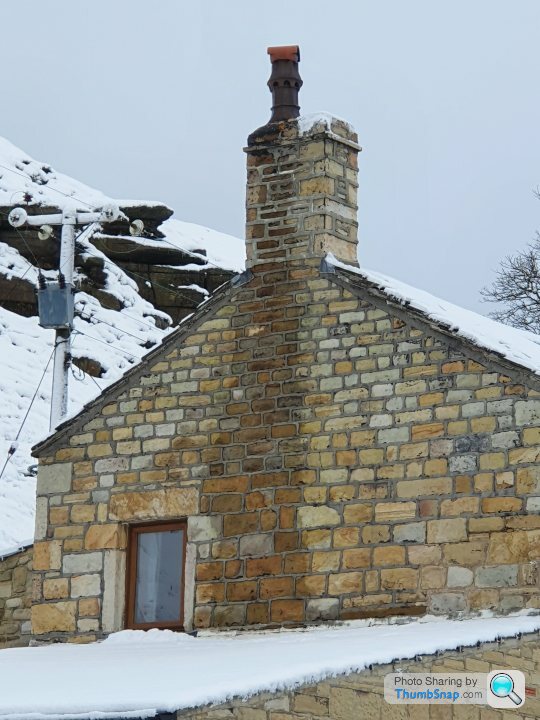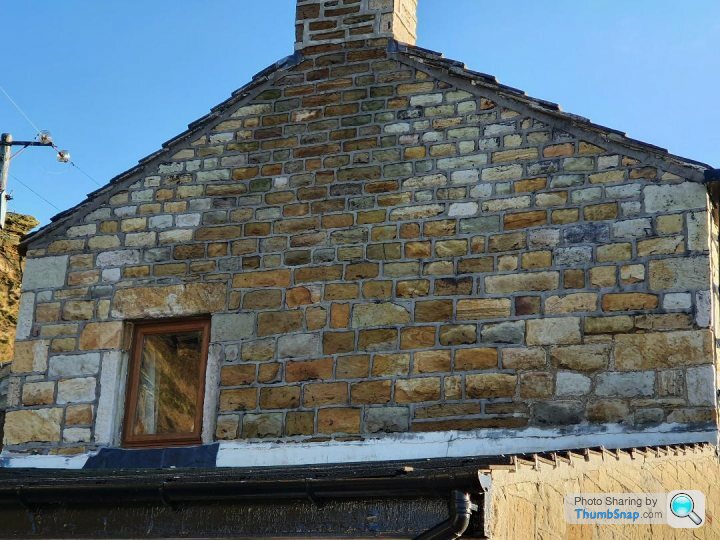Is my house wall freeze dried?
Discussion
I wasn't sure whether to post this in Science or here, we'll see how it goes.
I wonder if you can get your heads around what is happening here with this interesting conundrum.
1st pic is how it was for a few hrs after a cold (-4) night, second pic is how it was before and after. Yes I know the pointing is wrong, it isn't about that.

The dark damp stone is where the chimney goes and the fire is indeed lit. The whole wall was visibly wet a few days ago (when it was freezing or above) and was all the same shade. It has gone back to the same too now the temps are lifting a bit.
We'd had -4 the previous night and no more than zero during the day and a fair bit of wind previous, but none when pics were taken.
So the dark stone is clearly damp and the wall either side appears dry on the surface. It's definitely something to do with the heat from the chimney, it seems that warm is wet and cold is dry. It's as if the warmth is allowing it to sweat and the cold has allowed it to dry and kept it that way, at least on the surface for a few hours, but exactly how is that happening, has it freeze dried it?

I'll have to watch out for it doing it again and get my infra red thermometer on it.
I wonder if you can get your heads around what is happening here with this interesting conundrum.
1st pic is how it was for a few hrs after a cold (-4) night, second pic is how it was before and after. Yes I know the pointing is wrong, it isn't about that.

The dark damp stone is where the chimney goes and the fire is indeed lit. The whole wall was visibly wet a few days ago (when it was freezing or above) and was all the same shade. It has gone back to the same too now the temps are lifting a bit.
We'd had -4 the previous night and no more than zero during the day and a fair bit of wind previous, but none when pics were taken.
So the dark stone is clearly damp and the wall either side appears dry on the surface. It's definitely something to do with the heat from the chimney, it seems that warm is wet and cold is dry. It's as if the warmth is allowing it to sweat and the cold has allowed it to dry and kept it that way, at least on the surface for a few hours, but exactly how is that happening, has it freeze dried it?

I'll have to watch out for it doing it again and get my infra red thermometer on it.
Freeze drying requires a vaccum to turn the water from liquid to vapour.
The cold is not allowing it to dry in the conventional sense it's simply frozen and looks dry. Moisture will evaporate out from and off the warmer surface making it look wet. Sandstone will absorb greater quantities of water than denser types like whin.
I suspect someone will be writing a considerably more detailed response than mine.
The cold is not allowing it to dry in the conventional sense it's simply frozen and looks dry. Moisture will evaporate out from and off the warmer surface making it look wet. Sandstone will absorb greater quantities of water than denser types like whin.
I suspect someone will be writing a considerably more detailed response than mine.

5s Alive said:
Freeze drying requires a vacuum to turn the water from liquid to vapour.
The cold is not allowing it to dry in the conventional sense it's simply frozen and looks dry. Moisture will evaporate out from and off the warmer surface making it look wet. Sandstone will absorb greater quantities of water than denser types like whin.
I suspect someone will be writing a considerably more detailed response than mine.
Just you and me then The cold is not allowing it to dry in the conventional sense it's simply frozen and looks dry. Moisture will evaporate out from and off the warmer surface making it look wet. Sandstone will absorb greater quantities of water than denser types like whin.
I suspect someone will be writing a considerably more detailed response than mine.


Yes I believe you're right. So I had:
Fire lit:
0'c and above = Completely wet wall
-4 = Warm by the fire is wet, cold wall is dry.
So then as if a gift by the Gods we had a convenient halfway point the other day to back up what we thought. We had a minus 2 night/day which revealed that if you go for a halfway point in temps you can expect the wall to react in a similar fashion. I.E. the warmth and cold have made it very roughly halfway more or less than they were before:

I would have to go check, but I think those two pale faced stones in the middle of the dark/damp stonework are projecting far enough for them to get dry at their extremities.
So thanks for the response. Whether you've seen my thread or not I don't know, but I'm watching how my old house reacts to the weather and also what I do to it, to gain a better understanding of what is going on and how to remedy damp issues.
Just bookmarked your house thread for reading later. I can imagine some of the issues you're facing as 3 yrs ago we moved into a renovated 1901 farm house in a courtyard shared with 4 others. It's quite unique and very recognisable so no pics as it would almost certainly identify us to the local scallywags.
Built from whinstone in the manner of a 0.5M thick drystone wall. Pointed inside and out but dry fill otherwise and rendered to match neighbouring properties. The chap coring the wall for the boiler flue was having kittens as the diamond core bit was jamming first in front and then behind as dry fill dropped down. ("Do you want me to continue because if it fouls both ways we're stuck?!!) Took him a very nervous and sweaty 50 minutes to get through. Great fun.
Built from whinstone in the manner of a 0.5M thick drystone wall. Pointed inside and out but dry fill otherwise and rendered to match neighbouring properties. The chap coring the wall for the boiler flue was having kittens as the diamond core bit was jamming first in front and then behind as dry fill dropped down. ("Do you want me to continue because if it fouls both ways we're stuck?!!) Took him a very nervous and sweaty 50 minutes to get through. Great fun.

Gassing Station | Homes, Gardens and DIY | Top of Page | What's New | My Stuff



